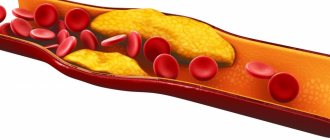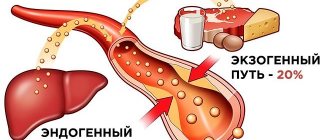This organic fat-like substance performs many important functions. Without it, the synthesis of hormones, the absorption of most vitamins, the formation of bile acids, and hematopoiesis are impossible. Most of the cholesterol is produced inside the body, about 20% comes from the outside, with food. An increase in the level of this compound is fraught with the development of atherosclerosis and other diseases. Excess cholesterol fills the lumen of blood vessels and settles in the gallbladder in the form of stones.
What is good and bad cholesterol
In tissues and blood, cholesterol forms special complexes with groups of lipoprotein proteins. They ensure its stable suspended state. Some of them have high density, others low. These properties of lipoproteins determine the types of cholesterol:
- “good”: HDL, protects cells from damage, ensures normal blood flow and vascular elasticity;
- “bad”: LDL, prone to precipitation, forming atherosclerotic plaques.
It is low-density cholesterol that is meant when they talk about its harm to health. This is true, since its excess is directly related to cardiovascular diseases, diabetes, poor circulation and the risk of strokes. LDL promotes the accumulation of triglycerides - simple fatty acids, overloads the liver, and contributes to the development of gallstones. High-density cholesterol inhibits these pathological processes and partially neutralizes the effect of the “bad”.
The role of cholesterol in the body
Cholesterol is a fat that ensures the normal functioning of the digestive and other body systems. This substance penetrates into it in two ways: it is produced by the liver, and it enters with food. Cholesterol is considered a vital element, however, when its amount increases, it becomes dangerous and can provoke the development of serious pathologies.
The correct name for cholesterol, given the chemical nomenclature, is “cholesterol.” Both of these names are used in medical practice.
The main functions of cholesterol in the human body are:
- participation in the formation of cell membranes, protecting them from external stimuli;
- responsibility for the permeability of cell membranes;
- production of sex hormones (in men - testosterone, in women - estrogen, cortisol);
- bile production;
- converting sunlight into vital vitamin D;
- exchange of fat-soluble vitamins: A, E, K and others;
- maintaining a high level of immunity.
Some find it surprising how such a useful element, which performs many functions in the human body, can be harmful. There are actually two types of cholesterol: high-density lipoprotein and low-density lipoprotein. The former are considered “good” cholesterol, the latter – “bad”. Due to the low density of lipoproteins, they begin to be deposited on the walls of blood vessels. Plaques formed in this way prevent normal blood flow in the affected arteries and vessels. As they increase, diseases of the cardiovascular system arise.
The main parameter studied in laboratories is total cholesterol - when calculating it, all types of the substance are taken into account. In addition to high and low density lipoproteins, there are also triglycerides. Indicators of normal cholesterol in the blood imply the ratio of all types of cholesterol.
Measuring cholesterol levels: general norms
To determine the level of cholesterol in the blood, a special unit is used: millimoles (mmol). Calculate the number of mmol per 1 liter of biological fluid. The total cholesterol content is important, as is the concentration of HDL and LDL separately. The level of triglycerides in the blood is also important, which is used to judge the risk of atherosclerotic changes in the body, disorders of fat metabolism and liver function.
- Normal total cholesterol: 3–7.8 mmol/l. During life it fluctuates depending on age and hormonal status. This is the average rate throughout life, the same for men and women.
- Low-density cholesterol—“bad” LDL—ideally should range between 1.8–2.8 mmol/L. The upper limit for women is up to 4.5 mmol/l. For men - up to 4.8 mmol/l. Its limit level: 5.7 mmol/l.
- The level of high-density “good” HDL is normally half that of “bad”: 0.8–2.4 mmol/l for women and 0.7–1.7 mmol/l for men.
The higher the low-density cholesterol level, the more critical the health condition. Especially if the level of a good high-density connection does not reach the norm:
- A regular increase in LDL levels to 4 or more mmol/l is dangerous;
- a constant decrease in LPV to 0.7 mmol/l also signals problems in the body.
Triglycerides are measured in the same way as other cholesterol levels. Their normal level in the blood throughout life is up to 2.2 mmol/l. It is the same for the male and female halves of humanity.
Signs of violations:
- elevated triglyceride levels: 2.3–5.6 mmol/l;
- dangerously high, signaling a disease: 5.7 mmol/l or more.
The risk of developing atherosclerosis is real at any age, but young people are more protected from it due to their high metabolic rate. Their cholesterol is quickly consumed by hormones and other physiological processes. Estrogen protects women from deposits of fatty plaques in blood vessels. However, with a sedentary lifestyle, a love of unhealthy foods, or the presence of systemic diseases, cholesterol also increases in young people. Over the years, its level grows even faster.
University
→ Home → University → University in the media → How to “lose weight” cholesterol
A biochemical blood test revealed a cholesterol level of 8.6. How to reduce the rate? What is the reason for the increase? Natalya SEIKO, the question was asked by email. mail.
The cholesterol content in the blood plasma of healthy people varies widely and depends, first of all, on age (the older you are, the higher the level) and gender (more in men). The average conditional upper limit is 5.17 mmol/l (200 mg/dl). Its content in the blood is considered increased when the level is above 6.2 mmol/l (240 mg/dl).
With a family history, arterial hypertension, diabetes mellitus, obesity, smoking, etc., the atherogenic effect of cholesterol increases significantly. It should be borne in mind that the combination of borderline high levels of the latter (5.2–6.2 mmol/l) and triglycerides (1.7–2.3 mmol/l), sometimes in lower concentrations, with other risk factors may influence the formation and progression of atherosclerosis.
The most important principle of treatment and prevention is the elimination or weakening of the effects of the main risk factors to reduce the destabilization of the atherosclerotic plaque. A pronounced positive effect can be expected with the simultaneous use of antiplatelet therapy, antioxidant enzymes, cytoprotectors, as well as by adjusting the activity of neurohumoral regulatory systems.
Non-drug treatment.
- The basis is a rational diet aimed at improving lipid metabolism and reducing excess body weight;
- physical activity;
- elimination of negative psycho-emotional effects.
Diet food.
Individually selected by the attending physician, it reduces the content of animal fats to 25–30% of the total energy value of food. Low-fat diets reduce total cholesterol and excess body weight, even when total energy intake is not limited.
A sharp decrease in saturated (up to 7–10% of the total energy value of food), an increase in monounsaturated (up to 10–15% of the total caloric value of food) and polyunsaturated (up to 10% of the total daily caloric value of food) fatty acids reduces the pool of free cholesterol and increases activity low density lipoprotein receptors.
Monounsaturated acids contain
- in peanut, olive, sunflower and corn oils,
Contains polyunsaturated
- in sunflower and corn oil
- in seafood products
- fish,
- bird,
- soft varieties of margarine.
The consumption of polyunsaturated acids should not be exceeded, as the total calorie content increases.
It is important to change the ratio of simple and complex carbohydrates in the diet. In low-fat diets, they account for 55–60% of the total calorie content of food. At the same time, easily digestible foods (sugar, jam, sweets, honey, etc.) are sharply limited or completely excluded. Carbohydrates should come in the form of vegetables, herbs, unsweetened fruits and berries. Of particular importance is fiber in raw fruits and vegetables (carrots, beets, cabbage), legumes (peas, beans), bran, etc. Their daily consumption provides a feeling of satiety and normalizes intestinal function.
It is better to avoid foods rich in cholesterol. Its total amount with incoming food should be less than 300 mg per day.
Rich in cholesterol:
- kidneys (per 100 g - 1126 mg),
- canned cod liver (746 mg),
- beef liver (438 mg),
- red and black caviar (up to 300 mg),
- egg yolk (200 mg),
- butter (190 mg),
- shrimp (150 mg),
- raw smoked sausage (105 mg),
- beef, lamb, pork fat (about 100 mg),
- crabs and squid (95 mg each),
- fatty meats, poultry, etc.
An important factor in the effectiveness of such nutritional correction is long-term (often throughout life) adherence to such diets.
Physical activity.
Correct and daily. Rational exercise improves the condition of people with high cholesterol levels. On average, daily activity should be about 8 hours and include walking, swimming or dynamic mobility, covering a distance of up to 10 km per week; 1–1.5 hours should be allocated for daytime sleep, and up to 8 hours for nighttime sleep.
Drug treatment.
Prescribed in the absence of the desired effect from lipid-lowering diets. If, with elevated cholesterol levels, the patient has atherosclerosis (of any localization) and/or diabetes mellitus, then the goal of therapy is:
- reducing low-density lipoprotein cholesterol levels below 2.6 mmol/L (100 mg/dL) without waiting for the results of a 6-12 week dietary trial, as recommended by the Cholesterol Control Program (USA, 1993);
- mandatory drug correction of hyperlipoproteins, which is ensured by strict adherence to the dietary recommendations described above;
- additional maintenance of plasma triglyceride levels below 1.7 mmol/L (150 mg/dL) and high-density lipoprotein cholesterol above 1.15 mmol/L (40 mg/dL).
In outpatient practice, several classes of lipid-lowering drugs are used: 3-hydroxy-3-methylglutaryl-CoA reductase inhibitors, or statins, bile acid sequestrants, fibrates, nicotinic acid and its derivatives.
Raisa NOVIKOVA , Associate Professor of the 1st Department of Internal Diseases of BSMU, Candidate of Medical Sciences. Sciences Medical Bulletin , June 18, 2009
Share
Changes in cholesterol standards by age in women
Differences in metabolism and the functioning of body systems at each stage of life also affect cholesterol levels. Over the years, due to a slowdown in metabolism, it inevitably increases. Changing total cholesterol averages for women:
- up to 5 years: from 2.90 to 5.18 mmol/l;
- 5-10 years: from 2.26 to 5.30 mmol/l;
- 10-15 years: from 3.21 to 5.20 mmol/l;
- 15-25 years: from 3.10-5.5 mmol/l;
- 25-35 years: from 3.37 to 5.96 mmol/l;
- 35-40 years: from 3.63 to 6.27 mmol/l;
- 40-50 years: from 3.81 to 6.53 mmol/l;
- 50-60 years: from 4.45 to 7.77 mmol/l;
- 60-70 years: from 4.45 to 7.69 mmol/l;
- 70 years or more: from 4.48 to 7.25 mmol/l.
A significant increase in the upper limit of indicators in women over 60 years of age is explained by the decline of ovarian function. During this period, the risk of obesity, type 2 diabetes, cardiovascular diseases, and osteoporosis increases.
Digestive system
The digestive system develops along with the body. On the one hand, it grows, matures, learns to digest new types of food. On the other hand, it must not only grow, but also through its work provide nutrition to cells and tissues with building materials and energy, as well as remove waste products. There are many more functions that the digestive system influences indirectly.
There can be many reasons for “indigestion” in a child. But it is important to remember that the main processes of food digestion occur in the small intestine with the participation of the pancreas. It is she who secretes the necessary enzymes that break down food into its component parts2. When, for various reasons, there are not enough digestive enzymes, food may not be completely digested, which often leads to symptoms of “indigestion.”
What can lead to “indigestion” in a child?2
- overeating, a sharp increase in load against the background of a favorable general condition;
- violation of the diet with obvious restrictions on any products;
- new products that the child tried for the first time;
- intestinal infections, poisoning, their consequences;
- use of antibiotics and other drugs;
- congenital characteristics, allergies, intolerance to certain foods;
- stress and emotional overload.
As many reasons as there are, there are just as many manifestations of digestive disorders.
The main symptoms of “indigestion” in a child:2
- heaviness in the stomach;
- discomfort after eating;
- bloating;
- flatulence.
If the digestive processes are disrupted for a long time, this can also manifest itself as diarrhea and even weight loss due to lack of nutrients.
Changes in cholesterol levels over the years in men
Men are naturally protected from atherosclerosis less than women. They do not have a high level of estrogen in the body, but they have a higher craving for bad habits that increase the risk of dangerous diseases.
Norms of total cholesterol in men:
- up to 5 years: from 2.95-5.25 mmol/l;
- 5-10 years: from 3.13 to 5.25 mmol/l;
- 10-15 years: from 3.08 to 5.23 mmol/l;
- 15-25 years: from 2.93 to 5.59 mmol/l;
- 25-35 years: from 3.44-6.58 mmol/l;
- 35-40 years: from 3.78-6.99 mmol/l;
- 40-50 years: from 3.91 to 7.15 mmol/l;
- 50-60 years: from 4.09 to 7.17 mmol/l;
- 60-70 years: from 4.12 to 7.15 mmol/l
- 70 years or more: from 3.73 to 7.86 mmol/l.
The closer the cholesterol level is to the lower limit of normal, the safer it is for blood vessels and the heart. Regular levels exceeding 5–6 mmol/l signal the need to prevent atherosclerosis. It is especially important to monitor indicators for men over 50 years of age. From this age their growth accelerates.
What is the danger of exceeding the norm?
The main complication of an increase in the amount of cholesterol in the body is considered to be atherosclerosis. This is damage to blood vessels by cholesterol plaques, due to which the lumen decreases and blood flow slows down. Usually the vessels and arteries of vital organs such as the heart, brain, and lungs are the first to suffer. If blood cannot circulate normally, then these organs suffer and their functionality is lost.
Atherosclerosis leads to the development of chronic heart pathologies. However, this disease is not the only possible complication. Due to excess cholesterol levels, the following may also develop:
- coronary heart disease - damage to the arteries through which oxygen passes;
- myocardial infarction;
- angina pectoris;
- stroke;
- other diseases of the cardiovascular system.
In particularly advanced cases, atherosclerosis and other complications can lead to the death of brain cells, heart cells, and cause human death.
Ways to Maintain Normal Cholesterol Levels
High levels are recorded in a biochemical blood test. If the numbers regularly exceed the norm, it is important to undergo a medical examination of the thyroid, pancreas, liver, and take a hormonal profile test. To normalize fat metabolism, courses of antilipid drugs are prescribed.
A therapeutic diet low in meat and dairy products also helps lower total cholesterol. It is useful to include sea fish containing Omega-3 complex, olive, flaxseed, sunflower oils, fresh vegetables, and herbs in your food.
Causes of high cholesterol
There are many reasons why there is more cholesterol in the blood than necessary. They can be combined into the following main groups:
- Obesity. Gaining extra pounds is accompanied by an increase in body fat, including “bad” cholesterol. And also, most obese people intentionally eat a lot of fatty foods.
- Nutrition. Even thin people who eat a lot of fatty foods can increase their cholesterol.
- Sedentary lifestyle. The blockage of blood vessels by cholesterol plaques occurs more intensely if a person leads a sedentary lifestyle and there is no physical activity.
- Alcohol. Alcohol abuse puts serious pressure on the liver, the organ that produces lipoprotein enzymes. As a result of the load on it, the production of “good” cholesterol is blocked, and the accumulation of “bad” cholesterol increases.
- Other bad habits. Smoking and drug use, including “light” drugs, also negatively affect liver function and contribute to an increase in “bad” cholesterol.
Most of the reasons for high cholesterol are related to a person’s unhealthy lifestyle.
Why is a high level dangerous and how does it manifest itself?
High blood cholesterol levels can manifest themselves in cases where they do not decrease over time. Accumulations on the walls of blood vessels reduce the lumen, and as a result, too little oxygen and nutrients enter the body.
Because of this, older people are at risk of developing unfavorable angina, as well as heart attacks and even cardiac arrest.
Mood swings, severe drowsiness and causeless apathy may indicate that something is wrong in the body. Chest pain, heaviness and stiffness in the legs, as well as varicose veins and swelling can be some of the manifestations of high cholesterol.
If older people feel unwell, it is recommended to consult a doctor and take a blood test. Tests should be taken regularly to identify problems with cholesterol levels in time.
Deviations in cholesterol levels in one direction can lead to pathologies of the heart, blood vessels and even more serious consequences, so men and women over the age of 50 should closely monitor their health. It is important to remember that you should not engage in self-treatment. This should be controlled by a specialist.
References
- Aster, D., Fausto, N., Vinay, K., et al. Fundamentals of disease pathology according to Robbins and Cotran. - M.: Logosphere, 2014. - 624 p.
- Severin, E.S., Aleynikova, T.L., Osipov, E.V., etc. Biological chemistry. - M.: Medical Information Agency LLC, 2008. - 364 p.
- Guyton, C., Hall, E. Textbook of Medical Physiology. 13th Edition, 2015. - P. 1075-1093
- Mach, F., Baigent, C., Catapano, A. et al. ESC/EAS guidelines for the treatment of dyslipidaemias: lipid modification to reduce cardiovascular risk. Russian Journal of Cardiology, 2020. —Vol. 25(5). - P. 3826.
At-risk groups
There are also predisposing factors that contribute to increased production of “bad” cholesterol. These include:
- heredity;
- disturbances in the functioning of the endocrine system;
- chronic liver and kidney diseases;
- uncontrolled use of certain drugs, especially hormonal ones;
- early menopause in women.
If at least one of these factors is present, it is necessary to carefully observe preventive measures so that blood counts are normal. By themselves, they are the causes of high cholesterol, but in combination with each other or an incorrect lifestyle, they can serve as an impetus for the development of problems.






